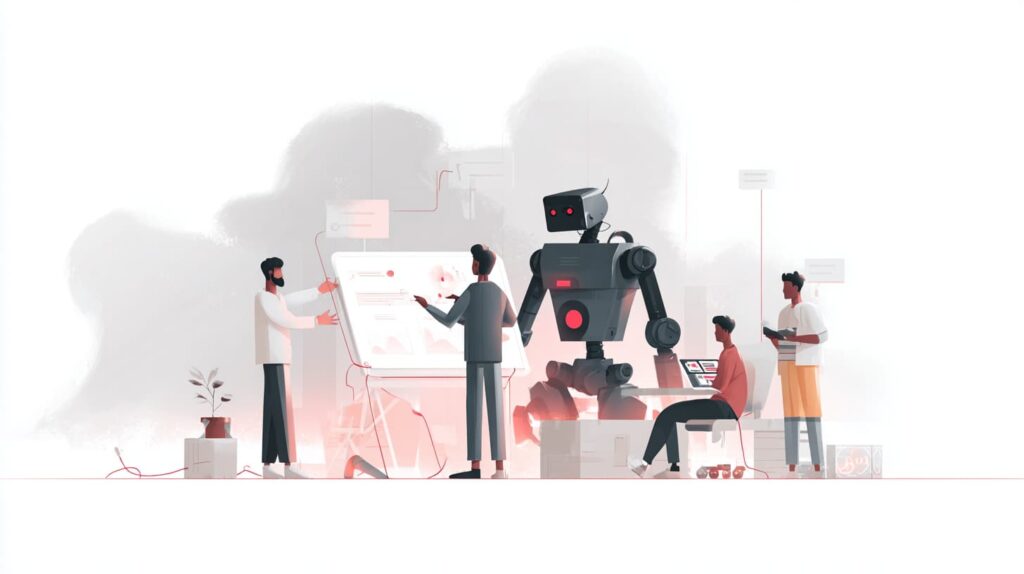By EloInsights, in collaboration with Pablo Cerri and Biagio Perazzo
- The EloGroup case involved transforming the operating model of the communications department of a global mining company.
- The company implemented an agile model to avoid overlapping roles, optimize deliveries and amplify value generation.
- The project included the implementation of enabling solutions, including a demand centralization tool, a portfolio review and the creation of a creative studio.
Agile methods, which have evolved since the mid-1990s, culminating in the launch of the Agile Manifesto in February 2001, were born applied to the discipline of software development, aiming to overcome more rigid models, such as waterfall, and, thus, guarantee greater delivery of value. In its last two principles, the manifesto states that “the best architectures emerge from self-organizing teams” and that, on a regular basis, “the team should reflect on how to become more effective and refine its behavior”.
Despite being born within a specific context, the idea of the importance and gains of working within self-organizing units, capable of reshaping and adapting organically, has since spread to many other areas.
The EloGroup case we will present in this article, on one of the largest mining companies of the world, illustrates how agile logic can be successful. On this business specifically, it involved redesigning the communications department.
In this Insight, we will describe some of the pains that led the communications department, consisting of 141 professionals, to opt for a redesign, the immersion methods that allowed for a more in-depth diagnosis of these pains, as well as the process of moving towards an agile logic and the results that have already emerged from this transformation.
Evidence of the need for transformation
There was a lot of evidence pointing out the fact there was something that could be changed in the way the mining company’s communications department worked. The pain could also be seeing throughout the various regional offices of the business, over five Brazilian states.
Each of these locations had its own communications division that met several of the company’s demands. In addition to these regional teams, there were also corporate teams working in a logic that, in many cases, lead to overlapped demands. By itself, this highlights the possibility of expanding value generation through an organizational rearrangement.
Another problem was that these regional cells often acted “detached” from the corporate team, carrying out actions that were not necessarily aligned with the company’s larger strategy.
Therefore, EloGroup began an in-depth process of investigating the reality of the communications area in order to establish a diagnosis. During this immersion stage, 36 interviews were carried out, as well as workshops aimed at going into greater detail about the pains initially reported.
These interviews were carried out with the company’s leaders, as well as analysts from the communications department, the global teams and the department’s interface areas. In this process, 65 pain points were identified. Based on it, 13 major insights were drawn into the structural problems of the communications department.
There were, for example, multiple interface areas. Without a single channel to combine all the demands, it was difficult to establish a strategic prioritization logic.
The existence of different coordination axes in the structure led to overlapping roles and responsibilities, which also hindered and strangled the department’s value generation. A lack of focus on core communication activities, the absence of a single, optimized agenda and a corporate vision that was detached from the top were other pains faced.

Mapping external trends
Another important part of the process, prior to defining a new operating model, was gathering insights related to trends in the communications area from an external market lens. This stage goal was to identify some of the best practices and gather information that would support the decision as to which model would be able to best take advantage of these trends that point to the future of the business in terms of communication.
Some of the trends identified included greater integration between internal and external communication and the increased use of analytical intelligence to improve performance. Although this area has traditionally been seen as creative, it is now experiencing an increase in the importance of incorporating data analysis skills as a mechanism to further foster creativity and guide performance improvement.
When done correctly, proper data analysis allows the company to get to know its audiences better, enabling greater personalization, and allows the area to be more assertive and efficient in its actions.
This is where the test & learn logic applied to communication comes in – that is, the possibility of carrying out a series of tests to try out with the public which approaches are most adherent. Example: testing, when publicizing an event, which visual elements have the greatest engagement with the selected audience.
With all these key insights in hand, it is time to make a decision: which operating model would give the communications department greater capacity to incorporate these new trends, increasing its flexibility and potential to generate value for the company as a whole?
Moving towards an agile model
The sum of the internal and external investigations carried out by EloGroup allowed the project to move into the next stage of defining a new operating model, considering all the insights generated from the immersion.
The choice was made for an agile model, capable of giving the board the flexibility it needed to adapt to the dynamic demands of the organization and, at the same time, the ability to optimally manage its structure to solve these demands with maximum synergy in relation to the mining company’s larger strategy, solving its problems, such as the overlapping roles and the deviations from the board’s core activities.
“We realized that choosing an agile method, in which the area could allocate resources according to the specificity of each demand, would generate greater value delivery and an efficiency gain in relation to the team’s delivery capacity,” explains Pablo Cerri, manager at EloGroup. “This would happen because the allocation would be made according to the skills and allocation time required for each demand.”
This model would have a service and project management area, responsible for centralizing the receipt of requests and demands (with the possibility of requests being forwarded directly by the areas via a digital tool), and an axis with communication expertise.
This axis of expertise would be made up of chapters specializing in press, brand, advertising, digital media, internal communication, among others. They would receive the company’s demands, centralized by a demand management tool, as we will see below.
Some of the directorate’s specificities were also considered. Some areas of expertise, such as communication with communities, required analysts to be physically present in their respective regional offices, which is why this issue was taken into account when planning the relocation of people to their new positions.
The roles were defined by listening to each of the analysts. The leaders were listened to in individual meetings, in which demands, desires and expectations regarding future positions in the company were received.
Enabling solutions
The agile method requires the organization to have optimum visibility of the demands and of the team’s capacity to meet each one. Otherwise, human capital management becomes chaotic and the ultimate goal of generating more value is made impossible. This way, the choice of this model led to the need to implement three enabling solutions within the directorate that were not yet part of its reality:
- A Microsoft Power Automate digital tool capable of centralizing the requests sent to the communications directorate and of providing an overview of what was being executed. It would provide a vision of the team’s “capacity”. In short, a demand management tool that would give greater visibility and control of the tasks being carried out.
- It was also necessary to carry out an in-depth analysis of the product portfolio to make it more connected to the communication strategy. In this review and organization process, the portfolio was separated into categories of tasks: that should not be carried out by the communications director and were therefore eliminated; that the client area could carry out on its own, based on manuals and guides created by the directorate; and others that would remain within the scope of action and could be improved. The goal was to ensure greater value delivery from the whole team. In this review, 11 sub-products were discontinued, 42 redirected, and 54 kept as improvements.
- Finally, the third enabling solution involved the implementation of a creative studio, a creative nucleus focused on preparing the audiovisual demands requested by the communications area, as well as being responsible for managing the integrated third-party agencies contracted. Its main objectives were to generate delivery capacity, provide economies of scale and standardize the materials produced. To support the area, an automated chatbot was created to answer simple questions, such as about the use of photos, branding and institutional materials.

Implementation and initial results at the mining company
The new model was implemented gradually, by region, from the smallest to the largest, including the corporate sector. An important part of this process was the creation of “start-up squads”, or thematic nuclei, which housed, according to specific communication demands, professionals from the vertical axes of expertise to work on demands in key areas of the company.
One example of a squad created was the People, with employees from the digital media and press areas, among others, to take on tasks related to issues such as diversity and inclusion, recruitment and selection. Another case was the Innovation squad, involved in a scope that included fostering startups, external partnerships and issues related to new technologies. The Cultural Investments squad brought in professionals to deal with activating company sponsorships and managing cultural assets.
Although these “starting squads” are intended to lay the foundations for working within a new agility logic, they must not stop there or be based on a rigid logic. The agility model provides for flexibility in these “cellular” structures, with the emergence and dissolution of these professional grouping cells as the dynamic environment of internal and external demands changes over time.
As the company becomes more mature in its ability to work within the new model, the tendency is for the squads to become increasingly assertive in meeting demands and in their synergy with the organization’s real needs.
All this transformation naturally required a series of training sessions and workshops with leaders and analysts, reinforcing the basics of the agile methodology, the importance of rites, how squads work and other concepts. In a matter of months, all the regional handovers had been carried out and the communications department was ready to roll with the new model.
Immediately after the completion of the project, the advantages of moving to a model with greater capacity to control the execution of demands and flexibility in the allocation of resources are already beginning to be seen by the mining company’s communications leadership.
Specialized professionals, who used to work separately and disconnected, now, collaborate more closely, increasing the exchange of experiences and boosting their ability to deliver value to the organization. In addition, project management has been more streamlined, providing significant economies of scale.
An internal survey showed that the problem of overlapping roles and responsibilities has been mitigated, as has the overload of employees and the need for rework during projects. Meeting efficiency increased, and satisfaction among leaders with the result of the transformation was 100%.
The continuous recalibration of teams within the new model will continue to be a natural challenge, as will adapting to the main daily challenges of the operation, greater use of data to increase value generation, and the development of a knowledge management and governance strategy that is capable of reusing materials that have already been built.
Organizational transformation is a continuous process whose premise is its capacity for feedback and permanent evolution. In this way, companies guarantee their ability to remain sustainable in the long term, based on models that make them more agile and efficient in delivering value to the entire organization.
Want to learn more about how EloGroup can help your company rethink its operating model, capture more value and gain efficiency? Talk to one of our specialists!
PABLO CERRI works as Manager at EloGroup.
BIAGIO PERAZZO works as Case Leader at EloGroup.











